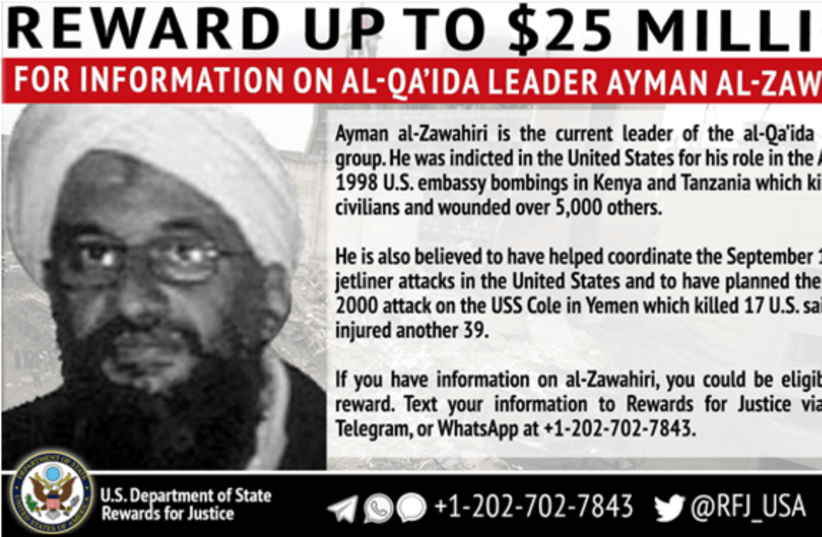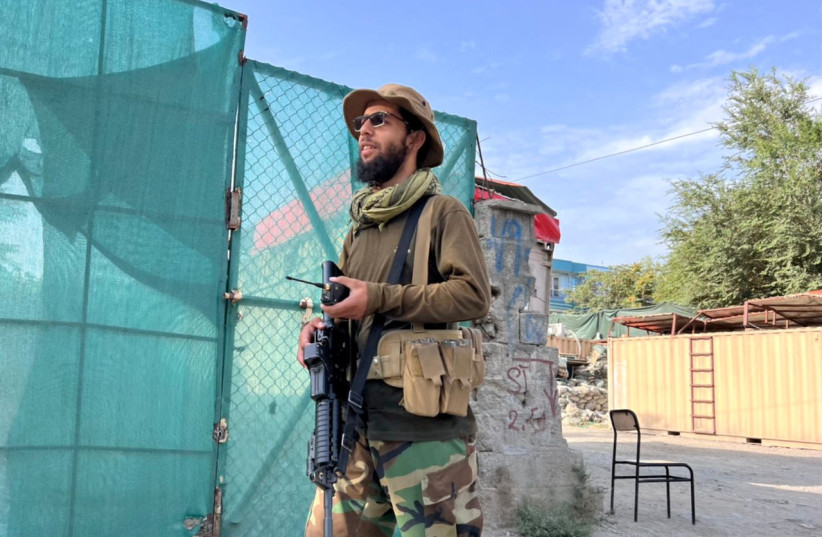The US finally found and killed Ayman al-Zawahiri, the leader of al-Qaeda. He was found on Sunday in the Afghan capital of Kabul, where he was killed in a counter-terrorism operation carried out by the CIA, the BBC reported.
“Since the United States delivered justice to [Osama] bin Laden 11 years ago, Zawahiri has been a leader of al-Qaeda,” US President Joe Biden said. “From hiding, he coordinated al-Qaeda’s branches and all around the world, including setting priorities for providing operational guidance and calling for and inspired attacks against US targets.”
How was Zawahiri killed?
Some have postulated that Zawahiri was killed with a Hellfire RX-9, a missile that uses blades instead of a warhead to literally mince up an adversary upon impact. The reason because there doesn’t seem to have been an explosion when the al-Qaeda leader was killed. Unlike the raid to kill Bin Laden in 2011, there was no firefight before Zawahiri was killed. Apparently, no family members were killed in the operation either.
Zawahiri was killed by two missiles as he stood on his balcony, according to reports. It took months of planning, supposedly. He was living a life of privilege in his “safe house,” which was located in a nice part of Kabul. His wife and grandchildren lived in the same house, which according to the Daily Mail, was “owned by a top aide to Sirajuddin Haqqani, the interior minister for the Taliban, who is close to senior al-Qaeda officials and is wanted by the FBI for questioning.”
The fact that Zawahiri was living in downtown Kabul, not far from various embassies, shows how he likely enjoyed support. Bin Laden also enjoyed support up until the end, when he was found in Abbottabad near a key Pakistani military school. The most-wanted terrorists are nearly always found living lives of privilege, usually with top-level official support in various places.
The head of ISIS, a genocidal murderer who took women as slaves, was found living within shouting distance of the Turkish border. Turkey is a “NATO ally” but many ISIS members transited the country and many leading members of ISIS have been found near the Turkish border in Idlib, not far from a key border crossing.
An ecosystem of terror
Members of other extremists groups have also been found in Turkish-occupied areas of Syria. Terrorist masterminds don’t live in a vacuum. They are part of an ecosystem, one that is often backed by groups that have ties to key countries. For instance, al-Qaeda emerged among privileged men in the Gulf, many of whom had ties to the upper levels of Saudi society in the 1980s.
ISIS emerged from thousands of men who came from Europe to Syria. Al-Qaeda had backing from Pakistan, and when the Taliban returned to power last year, it seems they gave support to Zawahiri. The Taliban for years were hosted in Qatar, a US partner country that has also hosted Hamas members and backed other extremists.
This means that while it is easy to write headlines about how the US tracked down some terrorist leader, these leaders don’t exist on the Moon. Many of them exist more in the milieu one finds in Godfather II, where the leader of the mafia family lives openly in splendor and has official connections. Yes, he is a criminal, but he is also sometimes useful to authorities.
Who was Ayman al-Zawahiri?
Ayman al-Zawahiri was born in Egypt in 1951. He was born to wealth, like Bin Laden. He lived a life of privilege, and like many privileged, entitled men, he gravitated toward hate and extremism. This was an era in the 1960s and 1970s when the West was coddling extremists and hate-filled terrorists.
Under the banner of “armed struggle,” many terrorists got positive coverage as if they were romantics in the West. The more they posed with guns and said they hated “Jews and Crusaders,” the more they seemed like “noble savages” who could be backed not only by college radicals but also members of Western intelligence services, who saw in them potential to be used against the Soviets.
This nexus, of coddling by the West and privilege at home, became a toxic mix that helped provide for a generation of men to run into the arms of religious extremism. Their extremism was coddled, but it was also nurtured at home by those who believed that nationalist and “secular” leaders of many countries in the region were not providing the answers people needed.
For a while, these men had the run of things, destabilizing countries across the Middle East, carrying out genocides against minorities, and eventually leading to 9/11 and other crimes.
Zawahiri studied medicine and graduated before joining the Muslim Brotherhood. It’s worth noting that the extremist and intolerant brotherhood is the same group that inspired Hamas founders and the leaders of the AKP Party in Turkey. Zawahiri was arrested following the assassination of former Egyptian president Anwar Sadat. He became more extreme in prison. Released in 1985, he went to Peshawar in Pakistan, where many similar radicals were gathering to fight the Soviets in Afghanistan.
Zawahiri kept up his terrorist work in Egypt as head of Egyptian Islamic Jihad. With the Cold War ending, he and Bin Laden gravitated toward new opportunities. Zawahiri apparently attempted to join jihadists fighting Russia in the Caucasus and went back to Afghanistan in 1997. He and Bin Laden joined their organizations in February 1998, forming the “World Islamic Front Against Jews and Crusaders.”
These men were still living lives of privilege. Even though Zawahiri was involved in plotting massacres, such as the Luxor attack on tourists in 1997 in Egypt, he was also traveling in the 1980s and 1990s. Allegedly using various passports, he went to Switzerland, Sarajevo, Malaysia and other places.
It’s worth recalling that many al-Qaeda planners had this jet-set access in the 1990s. With the Cold War over, the US was a global hegemon. It didn’t concern itself with these smaller, pesky terrorists. Therefore, they could easily transit via countries like Pakistan, which backed al-Qaeda and the Taliban.
They also had support in the Gulf. Key writers in Saudi Arabia and the West found al-Qaeda romantic. Reports say that in May 1988, Jamal Khashoggi went to Afghanistan and met with members of al-Qaeda. In 1993, a headline in The Independent described Bin Laden by saying, “Anti-Soviet warrior puts his army on the road to peace.”
But these were not peaceful men. These were antisemitic murderers who sought to massacre innocent people all over the world. This al-Qaeda was a far-right organization, no different than fascism and Nazism. Yet in the 1990s, it was still being coddled even as it planned the bombing of US embassies in 1998 and then the attack on the USS Cole in Yemen in 2000. At the time, the US saw it as a law enforcement problem.
Although there were some efforts to go after al-Qaeda, any real attempts to neutralize it before 9/11 came to naught. As such, these men enjoyed their privileged lives while planning wars all over the world, up until the attacks on New York and Washington. Zawahiri was hosted by the Taliban, the same Taliban that hosted him up until his death this week, the same Taliban that had been backed by Pakistan and hosted in Qatar. Yet the US was working with the same countries that were hosting this supposedly “most wanted” terrorist.
In the end, Zawahiri and his brand of terrorism changed in the 2000s. After 9/11, he became hunted, to some extent. The crown of terrorist extremism moved to new groups, such as ISIS and younger al-Qaeda cadres in Iraq. This new generation of killers didn’t care as much about large symbolic attacks, such as targeting embassies or tourist sites in Egypt, or world leaders. Indeed, Zawahiri was believed to have been behind plots against Egyptian leaders as well as the assassination of former Pakistani prime minister Benazir Bhutto.
The new generation of terrorism
The new generation of terrorists was more sectarian than al-Qaeda and more interested in total ethnic cleansing of minorities in places like Iraq. The Gulf countries also shifted from giving some succor to the extremists to turning against the Muslim Brotherhood and al-Qaeda.
Without cash from the Gulf and with extremism drying up in the Middle East, the new generation of terrorists is more likely to come from Europe, Africa or Asia. The world has changed. Unfortunately many people paid the price for that change, especially minorities such as the Yazidis in Iraq.
The lesson of people like Zawahiri is that we should confront extremists early in their careers. He enjoyed immense privilege most of his life. He was a globetrotter while al-Qaeda members were holding court for journalists in the 1990s. Even as people were saying “never again” about the Holocaust, they were willing to romanticize or excuse the al-Qaeda “war on the Jews and Crusaders.”
Two decades too late
Zawahiri was killed two decades too late. He should have been neutralized long ago, but he kept getting away with his deeds. Whether it was leaving prison in Egypt in the 1980s, or getting away from Russia in the 1990s, he evaded capture and containment. He was hoping to live out the life of an honored terrorist emeritus with his friends in Afghanistan, marveling at how the Taliban had returned to power with even more international backing than in the 1990s.
Indeed, the Taliban lived the high life in Doha, and they likely are backed by Iran, Russia, Pakistan and several other states today. Zawahiri must have found it all a bit comical, a “most-wanted man” living near the embassies of foreign countries in Kabul, having seen his friends return to power after 20 years fighting the Americans and others.
He met his end without really facing justice. And in the end, it was easier to turn him into mincemeat than have him answer for his crimes, a part of history quickly swept under the carpet so we can have closure to that era.

